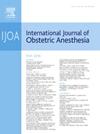Pain severity during infiltration of local anesthesia before spinal anesthesia as a predictor of post-cesarean pain and Obstetric Quality-of-Recovery scores (ObsQoR-11): a prospective observational study
IF 2.3
3区 医学
Q2 ANESTHESIOLOGY
引用次数: 0
Abstract
Background
Pain during infiltration of local anesthesia (ILA) before spinal anesthesia is a clinical measure shown to predict post-cesarean pain. We evaluated ILA as a predictor of post-cesarean pain and functional recovery.
Methods
Patients undergoing cesarean delivery with neuraxial anesthesia were recruited. Pain during ILA (lidocaine 1% 3 mL) was assessed with numerical rating scale (NRS; 0–100). At 24 hours postpartum, six NRS pain scores (average and peak pain at rest, movement, and uterine cramping), ObsQoR-11 and global health rating were recorded. Outcome data compared three groups according to pain during ILA: mild (≤30), moderate (31–69), and severe (≥70). Principal component analysis was used to determine the number of effective independent tests and P value thresholds (resulting in significant P <0.017 for primary outcomes and P <0.013 for other outcomes).
Results
Of 114 participants, 83 (72.8%) had mild ILA, 24 (21.1%) had moderate ILA, and 7 (6.1%) had severe ILA. Median rest pain was 20.0 (95% CI 10.0 to 20.0) in mild ILA group, 35 (95% CI 20.0 to 50.0) in moderate ILA group, and 45.0 (95% CI 30.0 to 60.0) in severe ILA group (P <0.001). Median ObsQoR-11 score was not significantly different between groups (90.0 (95% CI 83.0 to 92.0), 74.0 (95% CI 65.0 to 79.0), and 88.0 (95% CI 58.0 to 90.0), respectively; P = 0.021). Median global health rating at 24 hours was 70.0 (95% CI 70.0 to 73.0), 60.0 (95% CI 50.0 to 67.5), and 70.0 (95% CI 40.0 to 80.0), respectively (P =0.010).
Discussion
Our findings suggest that pain during ILA may serve as a clinical predictor of post-cesarean pain; however, it was not associated with lower ObsQoR-11 scores.
腰麻前局麻浸润期间疼痛严重程度预测剖宫产后疼痛和产科恢复质量评分(ObsQoR-11):一项前瞻性观察性研究
背景:脊髓麻醉前局麻浸润疼痛(ILA)是预测剖宫产后疼痛的临床指标。我们评估了ILA作为剖宫产后疼痛和功能恢复的预测因子。方法选取经神经轴麻醉剖宫产的患者。采用数值评定量表(NRS;0 - 100)。在产后24小时,记录六项NRS疼痛评分(休息、运动和子宫痉挛时的平均和峰值疼痛)、ObsQoR-11和整体健康评分。结果数据根据ILA期间的疼痛比较三组:轻度(≤30),中度(31-69)和重度(≥70)。主成分分析用于确定有效独立检验的数量和P值阈值(主要结局P <;0.017,其他结局P <;0.013)。结果114例患者中,轻度ILA 83例(72.8%),中度ILA 24例(21.1%),重度ILA 7例(6.1%)。轻度ILA组静息痛中位数为20.0 (95% CI 10.0 ~ 20.0),中度ILA组为35 (95% CI 20.0 ~ 50.0),重度ILA组为45.0 (95% CI 30.0 ~ 60.0) (P <0.001)。中位ObsQoR-11评分组间差异无统计学意义(分别为90.0 (95% CI 83.0 ~ 92.0)、74.0 (95% CI 65.0 ~ 79.0)和88.0 (95% CI 58.0 ~ 90.0);p = 0.021)。24小时全球健康评分中位数分别为70.0 (95% CI 70.0至73.0)、60.0 (95% CI 50.0至67.5)和70.0 (95% CI 40.0至80.0)(P =0.010)。我们的研究结果表明,ILA期间的疼痛可以作为剖宫产后疼痛的临床预测因素;然而,它与较低的ObsQoR-11评分无关。
本文章由计算机程序翻译,如有差异,请以英文原文为准。
求助全文
约1分钟内获得全文
求助全文
来源期刊
CiteScore
4.70
自引率
7.10%
发文量
285
审稿时长
58 days
期刊介绍:
The International Journal of Obstetric Anesthesia is the only journal publishing original articles devoted exclusively to obstetric anesthesia and bringing together all three of its principal components; anesthesia care for operative delivery and the perioperative period, pain relief in labour and care of the critically ill obstetric patient.
• Original research (both clinical and laboratory), short reports and case reports will be considered.
• The journal also publishes invited review articles and debates on topical and controversial subjects in the area of obstetric anesthesia.
• Articles on related topics such as perinatal physiology and pharmacology and all subjects of importance to obstetric anaesthetists/anesthesiologists are also welcome.
The journal is peer-reviewed by international experts. Scholarship is stressed to include the focus on discovery, application of knowledge across fields, and informing the medical community. Through the peer-review process, we hope to attest to the quality of scholarships and guide the Journal to extend and transform knowledge in this important and expanding area.

 求助内容:
求助内容: 应助结果提醒方式:
应助结果提醒方式:


